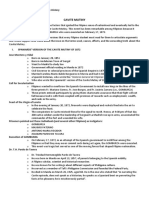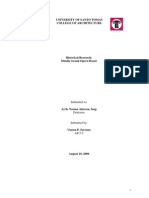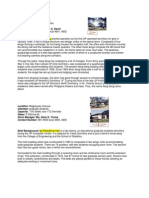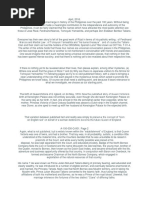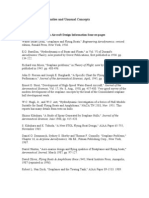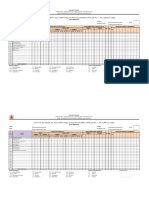Battle of Manila
Battle of Manila
Uploaded by
Cram Naj Rotse OnairutCopyright:
Available Formats
Battle of Manila
Battle of Manila
Uploaded by
Cram Naj Rotse OnairutCopyright
Available Formats
Share this document
Did you find this document useful?
Is this content inappropriate?
Copyright:
Available Formats
Battle of Manila
Battle of Manila
Uploaded by
Cram Naj Rotse OnairutCopyright:
Available Formats
3 February 3 March 1945
BACK0R0uNU
BACK0R0uNU
P n 1945, Manila was covered 14.5mi
2
with a population of almost one million.
P The scene of the worst urban fighting in
the Pacific Theater.
P Empire of Japan started invading
Manchuria (part of China) in 1931 .
P Full-scale assault against China in 1937.
BACK0R0uNU
P &.S. embargo on export of scrap iron
and steel with Japan and the freezing of
Japanese assets in the &.S. created
friction.
P The bombing of Pearl Harbor (known as
Operation Z) in 07 December 1941.
P McArthur's vow to liberate Filipinos led
to battles over the archipelago with the
city left as the last defense of Japs.
CAu3L3 0l C0NlLlC1
CAu3L3 0l C0NlLlC1
P The pursuit of the Americans to liberate
Filipinos and their own troops from Japs.
P The Japanese resistance against &.S.
troops.
P Gen. Yamashita then ordered Rear
Admiral wabuchi Sanji to hold the city in
order to give support to the retreating
Japanese forces.
UL3CRlP1l0N 0l l0RCL3
UL3CRlP1l0N 0l l0RCL3
BELLIGERENTS
&nited States
Filipino Guerrillas
Empire of Japan
NDERS
Oscar Griswold
Robert S Beightler
Verne D Mudge
Joseph M Swing
Alfredo M Santos
wabuchi Sanji
STRENGTH
35,000 &.S. troops
3,000 Filipino guerillas
10,000 Japanese sailors and marines
4,000 Army troops
UL3CRlP1l0N 0l l0RCL3
Weapons/ Fire Supports/ Defenses
75-mm. tank guns
76-mm. TD guns
105-mm. field artillery howitzers
155-mm. field artillery howitzers
240-mm. howitzers
8-inch howitzers
4.2-inch mortars
Mines
Fortification of garrisoned buildings
Pillboxes
Bunkers
Snipers
20-mm antiaircraft
40-mm. antiaircraft
25-mm. machine cannon
120-mm. dual-purpose naval gun
200-mm. Navy rockets
450-mm. Navy giants
asuaIties
1, 010 killed
5, 565 wounded
100, 000 Filipino civilians killed
12, 000 killed
1L BA11LL
B40KClUuNl
P Gen. Yamashita decided to leave Manila bec.
of the ff. reasons: (a) it is impossible to feed a
1 million pop'n, (b) buildings are very
inflammable, (c) Manila is on flat land that
requires tremendous strength to defend it.
P Yamashita's plan was to evacuate Manila and
leave behind a small Army force to maintain
order, protect supply movements, and to blow
up bridges over Pasig & Marikina Rivers to
delay Allied forces.
B40KClUuNl
P He organized $2-: group for a final
defensive stand in the mountain country east
and northeast of Manila.
P He placed the city and the Mana Defense
Force under General Yokoyama.
P Vice Adm. Denshichi Okochi, decided to
strengthen the Navy's defenses of Manila
Mana Nava Defense Force under Admiral
wabuchi Sanji.
1apanese lefenses
P The core of defenses was ntramuros
(walled city).
P Fortifying a semicircle of buildings
around the walled city.
1apanese lefenses
P A prime characteristic of the defenses
was man-made defenses of heavily
reinforced concrete buildings.
P Fortified building entrances with
sandbags.
P Barricades along corridors and
stairways.
P Tunnels that connected the basements
of various buildings.
1apanese lefenses
P Pillboxes and bunkers.
P Barricaded streets and intersections
throughout the city with all types of obstacles:
- barbed-wire entanglements
- oil drums filled with dirt or cement
- rails set into the pavement
- hastily dug ditches
- trolley cars, trucks, and automobiles
1apanese lefenses
P Employing mines.
P Mortars.
P Anti-aircrafts.
P Heavy artillery from.
P Japanese Navy's dual-purpose 120-mm. gun.
P Practically none of wabuchi's troops had any
unit training in ground combat operations and
many had very little individual infantry training.
1apanese lefenses
%e lano|ngs
P On 9 January 1945, the Sixth &.S. Army
under Lt.Gen. Walter Krueger waded
ashore on Lingayen Gulf and began a
rapid drive south.
%e lano|ngs
P On 31 January, the Eighth &nited States Army
of Lt. Gen. Robert L. Eichelberger, consisting of
the 187th and 188th Glider nfantry Regiments
of Col. Robert H. Soule, components of the
&.S. 11th Airborne Division under Maj. Gen.
Joseph M. Swing landed unopposed at
Nasugbu in southern Luzon and began moving
toward Manila. Meanwhile, the 11th A/B
Division's 511th Regimental Combat Team of
Col. Orin D. "Hard rock" Haugen parachuted
into Tagaytay Ridge on 4 February and
spearheaded the northern advance.
%e p|an
P V Corps reached Manila on 3
February.
P Stringent restrictions upon artillery
support fires and even tighter
restrictions upon air support operations.
P Securing the city's water supply facilities
and electrical power installations.
%e p|an
l|berar|on of lnrernees
P 2d Squadron, 8th Cavalry, moved into
Manila on the evening of 3 February to
liberate internees at &ST.
P 44th Tank Battalion broke through the
gates of the campus wall.
P After few fight, some 3,500 internees were
liberated.
P Sixty Japanese under Lt. Col. Toshio
Hayashi, the camp commander, held as
hostages another 275 internees.
l|berar|on of lnrernees
P Hayashi demanded a guarantee for safe
conduct from the ground for himself and
his men before he would release the
internees.
P On the morning of 5 February, forty-
seven Japanese were escorted out of
the university to the spot they requested.
l|berar|on of lnrernees
P The Japanese were unaware the area
they requested was near the American-
occupied Malacaang Palace.
P Afterwards were fired upon and several
were killed including Hayashi.
P 5,785 prisoners were liberated.
no|ro|emenr & Massaore
P 1st Cavalry Division in the north and the
11th Airborne Division in the south
reported stiffening Japanese resistance
to further advances into the city.
P n the north, General Griswold continued
to push elements of the V Corps south
from Santo Tomas &niversity toward the
Pasig River.
no|ro|emenr & Massaore
P Late on the afternoon of 4 February, he
ordered the 2nd Squadron, 5th Cavalry,
to seize Quezon Bridge, the only
crossing over the Pasig that the
Japanese had not destroyed.
no|ro|emenr & Massaore
no|ro|emenr & Massaore
P Japanese troops took out their anger
and frustration on the civilians caught in
the crossfire, committing multiple acts of
severe brutality, which later would be
known as the Manila Massacre.
P Violent mutilations, rapes, and
massacres on the populace
accompanied the battle for control of the
city, which lay practically in ruins.
levasrar|on of lnrramuros
P The fighting for ntramuros continued
from 23 February to 28 February.
P American forces used artillery to try and
root out the Japanese defenders.
P The last pocket of Japanese resistance
at the Finance Building, which was
already reduced to rubble, was flushed
out by heavy artillery on 3 March.
4frermar
P 1,010 &.S. soldiers dead and 5,565
wounded.
P 100,000 Filipinos civilians were killed.
P 12,000 Japanese soldiers died.
Al1LR BA11LL ANAL3l3
!r|no|p|e of Ubjeor|ve
P Americans have clear and consistent
goal that is to defeat Japanese forces at
the vicinity of Pacific Nations which have
completed at the end of the day. On the
other hand, wabuchi Sanji's objective in
defending the city was failed even if the
commander's intent was clear to all
subordinates due to some lapses in
execution.
!r|no|p|e of Mass
P Americans have a very good
concentration of the effects of combat
power at the decisive place and time.
The encirclement and bombardment of
ntramuros marked a very decisive
attack.
!r|no|p|e of Mass
P On the other hand, Japanese didn't
really fail to concentrate their force in
defending their position. They have all
the obstacles, anti-aircrafts, and tunnels,
but the problem is.soldiers are less
experienced.
!r|no|p|e of Seour|r,
P Japanese forces are well prepared. All the
buildings and streets at the north of Pasig
River are highly fortified by machine gun
nests, mines, and mortars.
P On the other hand, American forces are also
prepared because of their experience in
urban fighting. They have also heavy
artilleries that bombarded Japanese strong
points resulting to diminished enemy
resistance.
!r|no|p|e of Maneuver
P Americans were able to complete the
encirclement of Japanese defenses
leading them to great advantage over
the enemy.
P On the other hand, Japanese weren't
able to maintain their strong points in
short, defenses at the north of Pasig
River were defeated.
!r|no|p|e of Maneuver
P This was resulted to the push of &.S.
troops towards the ntramuros the
result, encirclement.
C0NCLu3l0N / LL330N3
C0NCLu3l0N / LL330N3
P Battle experience of troops is very vital
in winning the war.
P Supremacy in fire support was also the
life-line of &.S. troops in clearing the
northern part of the Pasig River.
P Securing vital installations like water
supply and power plants are also
important during the battle to deprive the
enemies' primary needs.
You might also like
- TAGUIGDocument9 pagesTAGUIGKael Echavez OpogNo ratings yet
- H.M.H.S BritannicDocument20 pagesH.M.H.S BritannicEnrico Miguel N SalvadorNo ratings yet
- Avida Towers Verge T2 Ugnayan - SharedDocument35 pagesAvida Towers Verge T2 Ugnayan - SharedRamil MoisesNo ratings yet
- Karyamulak AnusandhanDocument10 pagesKaryamulak AnusandhanSushil Paudel100% (1)
- Bloody War With Japanese InvadersDocument3 pagesBloody War With Japanese InvadersRachelle Danya Dela RosaNo ratings yet
- Module 2 - Part 2Document6 pagesModule 2 - Part 2Vernadel ApolloNo ratings yet
- Japanese Occupation PeriodDocument16 pagesJapanese Occupation Periodmarissa labatosNo ratings yet
- Research The Beginnings of Intramuros Start of Stone and Tile ConstructionDocument10 pagesResearch The Beginnings of Intramuros Start of Stone and Tile ConstructionElisha XDNo ratings yet
- Philippine HistoryDocument40 pagesPhilippine HistoryGracelle Anne Pajarillaga PadolinaNo ratings yet
- CHAPTER 12 - The Philippines Under The American RuleDocument72 pagesCHAPTER 12 - The Philippines Under The American RuleCONCORDIA RAFAEL IVAN100% (1)
- What Happened in The Cavite Mutiny?: Reading in Philippine HistoryDocument15 pagesWhat Happened in The Cavite Mutiny?: Reading in Philippine Historylalisa kimNo ratings yet
- History of General TriasDocument8 pagesHistory of General TriasClarisse Buclatin0% (1)
- Overview On Planning and Development of The City of Manila - FinalDocument4 pagesOverview On Planning and Development of The City of Manila - FinalMarissa SarmientoNo ratings yet
- Battle of ManilaDocument14 pagesBattle of ManilaviancaNo ratings yet
- GoyoDocument3 pagesGoyoRaphael OngNo ratings yet
- IntramurosDocument1 pageIntramurosVicheeckoOrtegaNo ratings yet
- The Philippine Declaration of Independence Occurred On June 12Document4 pagesThe Philippine Declaration of Independence Occurred On June 12Moises R Tordilla III63% (8)
- Philippine-China RelationsDocument33 pagesPhilippine-China RelationsJennifer Gayle Geranco FloresNo ratings yet
- 01 History of PlumbingDocument14 pages01 History of PlumbingRenz MonedaNo ratings yet
- Ccs - Kapampangan Part 1Document44 pagesCcs - Kapampangan Part 1Isa EcarwanNo ratings yet
- Japanese OccupationDocument5 pagesJapanese OccupationAimee Denosta100% (1)
- Burnham's Plan For ManilaDocument2 pagesBurnham's Plan For ManilaCoco Bagadion0% (2)
- Manila Grand Opera House Historical ResearchDocument14 pagesManila Grand Opera House Historical ResearchVinson Pacheco Serrano100% (1)
- Sym 2 Three Letter of Apolinario Mabini, Encarnacion Alzona, AcdDocument14 pagesSym 2 Three Letter of Apolinario Mabini, Encarnacion Alzona, Acdwendi03100% (1)
- Battle Review of PEFTOK in KoreaDocument3 pagesBattle Review of PEFTOK in KoreaJonathanAndroTan100% (1)
- Historical Background and Spanish Era Churches in The Philippines - AR 343A-ARCH32S1 - History of Architecture 4 PDFDocument13 pagesHistorical Background and Spanish Era Churches in The Philippines - AR 343A-ARCH32S1 - History of Architecture 4 PDFLailanie TreyesNo ratings yet
- Pigafetta Executive SummaryDocument13 pagesPigafetta Executive SummaryMark Russel MahinayNo ratings yet
- Up Residence HallsDocument4 pagesUp Residence HallsCarla AquinoNo ratings yet
- HistoryDocument11 pagesHistoryAbby BonggalNo ratings yet
- Apolinario MabiniDocument12 pagesApolinario MabiniNeil Constantino MartinezNo ratings yet
- Battle of Manila 1945 Essay EntryDocument2 pagesBattle of Manila 1945 Essay EntryAlphaNo ratings yet
- The Revolution, Second PhaseDocument4 pagesThe Revolution, Second PhasePercy Samaniego50% (6)
- The Ethnohistory of Northern LuzonDocument8 pagesThe Ethnohistory of Northern LuzonPhillip TagubaNo ratings yet
- People Power RevolutionDocument25 pagesPeople Power RevolutionGenevee Ryeleen DelfinNo ratings yet
- History of Cagayan de OroDocument3 pagesHistory of Cagayan de OroCarmelli Mariae Calugay100% (1)
- Revisited HistoryDocument20 pagesRevisited HistoryJonas CornejoNo ratings yet
- Isabelo de Los ReyesDocument12 pagesIsabelo de Los Reyeskim leiNo ratings yet
- 1st Mass ControversyDocument4 pages1st Mass ControversyAsh LyNo ratings yet
- American Imperialism and Education in The PhilippinesDocument14 pagesAmerican Imperialism and Education in The Philippinesapi-407869112100% (1)
- BataanDocument4 pagesBataanGenesis Adam De GuzmanNo ratings yet
- Social Science 1 - Reviewer For Assignment Quiz No. 3.2Document2 pagesSocial Science 1 - Reviewer For Assignment Quiz No. 3.2Antoine Miguel BorromeoNo ratings yet
- All Hands Naval Bulletin - Feb 1945Document84 pagesAll Hands Naval Bulletin - Feb 1945CAP History LibraryNo ratings yet
- The Battle of BataanDocument9 pagesThe Battle of BataanJack Daniel CandelarioNo ratings yet
- Battle of ManilaDocument3 pagesBattle of ManilaElsieJhadeWandasAmandoNo ratings yet
- Battle of Zig-Zag Pass BrinsonArthur CPTDocument19 pagesBattle of Zig-Zag Pass BrinsonArthur CPTcjnjr1100% (1)
- A Brief History of The First MarinesDocument49 pagesA Brief History of The First MarinesBob Andrepont100% (1)
- Japanese HegemonyDocument9 pagesJapanese Hegemonyjanegrace.hernandezNo ratings yet
- History Y2Document26 pagesHistory Y2xinyan02272No ratings yet
- A Legacy of Heroes: The Story of Bataan and Corregidor: Group 6: Aton, Barnes, Malla, PastoresDocument21 pagesA Legacy of Heroes: The Story of Bataan and Corregidor: Group 6: Aton, Barnes, Malla, PastoresVon Edrick RondaelNo ratings yet
- CMH Pub 11-1 Chronology 1941-1945Document673 pagesCMH Pub 11-1 Chronology 1941-1945yetinegroNo ratings yet
- Chap 5 Part II 2015Document49 pagesChap 5 Part II 2015Glenn WongNo ratings yet
- Armoured Warfare in the Far East, 1937–1945From EverandArmoured Warfare in the Far East, 1937–1945Rating: 4 out of 5 stars4/5 (3)
- The Battle of Leyte Gulf The History and Legacy of World War IIs Largest Naval BattleDocument68 pagesThe Battle of Leyte Gulf The History and Legacy of World War IIs Largest Naval BattleMarlon Manaya Garrigues100% (4)
- Attack On Pearl Harbour: Japanese Occupation and The War YearsDocument3 pagesAttack On Pearl Harbour: Japanese Occupation and The War YearsAilynne Joy Rojas LimNo ratings yet
- World War II: Battle of Bataan: Learn Something New Every DayDocument1 pageWorld War II: Battle of Bataan: Learn Something New Every DayDmitry Vladimir BelmontNo ratings yet
- CH 32 Sec 2 - Japan's Pacific Campaign PDFDocument5 pagesCH 32 Sec 2 - Japan's Pacific Campaign PDFMrEHsieh100% (2)
- Rcdig1070439 - 1-G. Hermon Gill 23 Australians at Taraka NDocument9 pagesRcdig1070439 - 1-G. Hermon Gill 23 Australians at Taraka Niii_333No ratings yet
- Advanced Design Studies and Unusual Concepts FLIYNG BOATSDocument2 pagesAdvanced Design Studies and Unusual Concepts FLIYNG BOATSviorelu99No ratings yet
- Paulina Tihonova Like 1: Ksenia TchernikovaDocument11 pagesPaulina Tihonova Like 1: Ksenia TchernikovaBrandon MuellerNo ratings yet
- Flanders FieldsDocument3 pagesFlanders Fieldsapi-267136654No ratings yet
- California Wing - Jan 2002Document56 pagesCalifornia Wing - Jan 2002CAP History Library100% (1)
- L2A3 SterlingDocument4 pagesL2A3 SterlingMamoun Kh OmariNo ratings yet
- Afd 070221 129 PDFDocument905 pagesAfd 070221 129 PDFArabyAbdel Hamed SadekNo ratings yet
- (Aviation) - Tactical - Aviation.tactics - Techniques.and - ProceduresDocument275 pages(Aviation) - Tactical - Aviation.tactics - Techniques.and - ProceduresBranislav LackovicNo ratings yet
- TalibanDocument72 pagesTalibanRAI AMIRNo ratings yet
- MMMX PDFDocument12 pagesMMMX PDFFelipe Valverde Chavez100% (2)
- 5e Weapon BreakdownDocument10 pages5e Weapon BreakdownGeorgeNo ratings yet
- Arms and The Man: Summary and Analysis Act IDocument3 pagesArms and The Man: Summary and Analysis Act IAratrika ChakrabortyNo ratings yet
- Intercessors AssaultDocument6 pagesIntercessors AssaultpliplojaponNo ratings yet
- Passive Battleship Game - WorksheetDocument1 pagePassive Battleship Game - WorksheetricardogonzalezdjNo ratings yet
- Catalogo CruzetasDocument35 pagesCatalogo CruzetasEdilson ScheleskiNo ratings yet
- Manila Bay Reclamation ProjectsDocument3 pagesManila Bay Reclamation ProjectsBlogWatch100% (1)
- Marina Star 2 Imo8115629Document2 pagesMarina Star 2 Imo8115629BerbisnisDanBersedekahNo ratings yet
- Sigma 40xpDocument2 pagesSigma 40xpVictor PileggiNo ratings yet
- Instant Access to High YieldTM Biostatistics Epidemiology & Public Health 4th FOURTH EDITION Anthony N. Glaser MD PhD ebook Full ChaptersDocument24 pagesInstant Access to High YieldTM Biostatistics Epidemiology & Public Health 4th FOURTH EDITION Anthony N. Glaser MD PhD ebook Full Chaptershukumampak100% (3)
- Augustus: 1 NameDocument33 pagesAugustus: 1 NamejazmontzNo ratings yet
- Assault RiflesDocument180 pagesAssault Riflesordddddddd100% (1)
- Drama Grade-11-2nd-TermDocument22 pagesDrama Grade-11-2nd-TermTomNo ratings yet
- Form Penilaian All AspectDocument6 pagesForm Penilaian All AspectHolmes MarbunNo ratings yet
- Clone Wars Episode GuideDocument7 pagesClone Wars Episode GuidenkjkjkjNo ratings yet
- Nevada State Guard HistoryDocument7 pagesNevada State Guard HistoryCAP History LibraryNo ratings yet
- PM Serajul IslamDocument6 pagesPM Serajul Islamarmishon89No ratings yet
- John KerryNewsHourInterviewDocument4 pagesJohn KerryNewsHourInterviewJustin KennyNo ratings yet
- tamurkhanQA PDFDocument5 pagestamurkhanQA PDFJames Phoenician TurnerNo ratings yet
- Ngos in MeerutDocument39 pagesNgos in MeerutmanuNo ratings yet
- Fussel - Thank God For The Atom BombDocument14 pagesFussel - Thank God For The Atom BombChetanya93No ratings yet





